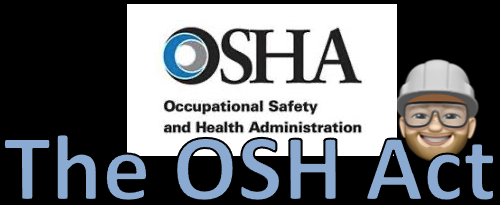
In order to really understand any Standard, or in the case, the Occupational Safety and Health Act (OSH Act), you need to truly understand the words that are used within them. This is why Congress, and OSHA, take the time to define words that can have multiple meanings or interpretations. Some of the defined words that I find particularly interesting in the OSH Act are:
- “employer” means a person engaged in a business affecting commerce who has employees, but does not include the United States (not including the United States Postal Service) or any State or political subdivision of a State (OSHA, 1970).
- “employee” means an employee of an employer who is employed in a business of his employer which affects commerce (OSHA, 1970).
- “commerce” means trade, traffic, commerce, transportation, or communication among the several States, or between a State and any place outside thereof, or within the District of Columbia, or a possession of the United States (other than the Trust Territory of the Pacific Islands), or between points in the same State but through a point outside thereof (OSHA, 1970).
- State” includes a State of the United States, the District of Columbia, Puerto Rico, the Virgin Islands, American Samoa, Guam, and the Trust Territory of the Pacific Islands (OSHA, 1970).
- “occupational safety and health standard” means a standard which requires conditions, or the adoption or use of one or more practices, means, methods, operations, or processes, reasonably necessary or appropriate to provide safe or healthful employment and places of employment (OSHA, 1970).
- “national consensus standard” means any occupational safety and health standard or modification thereof which (1), has been adopted and promulgated by a nationally recognized standards-producing organization under procedures whereby it can be determined by the Secretary that persons interested and affected by the scope or provisions of the standard have reached substantial agreement on its adoption, (2) was formulated in a manner which afforded an opportunity for diverse views to be considered and (3) has been designated as such a standard by the Secretary, after consultation with other appropriate Federal agencies (OSHA, 1970).
Right in the definitions you can begin to see the scope, and omissions, that the OSH Act are beginning to lay the foundation for. All “employers” who are involved in “commerce” are required to adhere to the “occupational safety and health standards”.
However, as identified, “employer” does not include the United States, any State, or political subdivision of a State.
Meaning, that police, fire departments, public utility workers, and state workers are afforded the same protection as other workers. Now there are a few exceptions like Connecticut and Massachusetts that have programs that protect State workers, but most do not.
References:
OSHA. (1970). OSH Act of 1970. https://www.osha.gov/laws-regs/oshact/completeoshact


